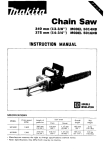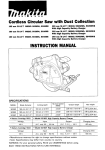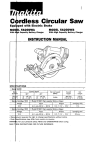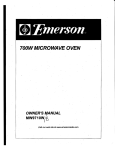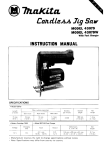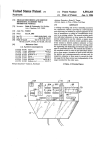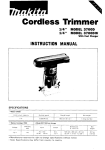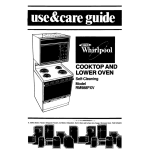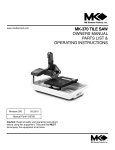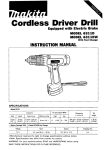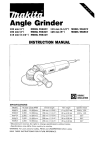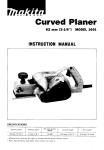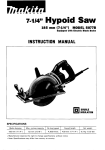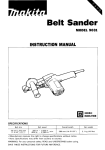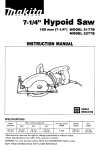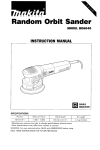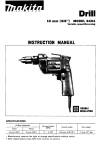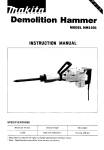Download Makita 5016NB Instruction manual
Transcript
Chain Saw 340 mm (13-3/8") 375 mm (14-3/4") MODEL 5014NB MODEL 5016NB INSTRUCTION MANUAL I DOUBLE INSULATION I SPECIFICATIONS MODEL 5014NB 501 6N8 Chain speed IFPM) 1,300 1,300 Length of guide bar Saw chain Pitch Gauge Overall length Net weight (13.318") 9.5 mm 1318") 1.27 mm (0.050") 760 m m 130") 6 kg (13.2 Ibs) 375 mm (14-314") 9.5 mm (318") 1.27 mm 10.050") 795 mm 131-114") 6.3 k g (13.9 Ibs) 340 mm IMPORTANT SAFETY INSTRUCTIONS WARNING: WHEN USING AN ELECTRIC CHAIN SAW, BASIC SAFETY PRECAUTIONS SHOULD ALWAYS BE FOLLOWED TO REDUCE THE RISK OF FIRE, ELECTRIC SHOCK, AND INJURY TO PERSONS, INCLUDING THE FOLLOWING: READ ALL INSTRUCTIONS. 1. Keep Work Area Clean Cluttered areas invite injuries. Do not start cutting until you have a clear work area, secure footing, and a planned retreat path from the falling tree. 2 . Consider Work Area Environment Use extreme caution when cutting small size brush and saplings because the slender material may catch the saw chain and be whipped toward you or pull you off balance. Do not operate a chain saw in a tree unless specifically trained t o do so. When cutting a limb that is under tension be alert for spring back so that you will not be struck when the tension in the wood fibers is released. Don’t expose chain saw t o rain. Don’t use chain saw in damp or wet locations. Do not use chain saw in presence of flammable liquids or gases. 3. Guard Against Electric Shock Prevent body contact with grounded surfaces. For example: metal pipes, wire fences. 4.Keep Children Away Do not let visitors contact chain saw or extension cord. All visitors should be kept away from work area. 5. Store Idle Chain Saw When not in use, chain saws should be stored in a dry, and high or lockedup place - out of the reach of children. When storing saw, use a scabbard or carrying case. 6 . Don’t Force Chain Saw It will do the job better and safer at the rate for which it was intended. 7 . Use Right Tool Cut wood only. Don‘t use chain saw for purpose not intended - for example - Don’t use chain saw for cutting plastic, masonry non-wood building materials. 8 . Dress Properly Do not wear loose clothing or jewelry. They can get caught in moving parts. Rubber gloves and non-skid footwear are recommended when working outdoors. Wear protective hair covering t o contain long hair. 2 9. Use Safety Glasses Also use safety footwear; snug fitting clothing; protective gloves; hearing and head protection. IO. Carrying Saw Carry the chain saw by the front handle with the saw stopped, finger off the switch, the guide bar and saw chain t o the rear. 11. Maintain Chain Saw With Care Inspect chain saw cords periodically and if damaged, have repaired by authorized service facility. Keep cord clear of the chain and operator at all times. Never carry saw by the cord or pull it t o disconnect from receptacle. Keep cord from oil and sharp edges. Inspect extension cords periodically and replace if damaged. Keep tools sharp and clean for better and safer performance. Follow instructions for lubricating and changing accessories. Keep handles dry, clean, and free from oil and grease. 12. Disconnect Chain Saw Disconnect chain saw when not in use, before servicing, and when changing accessories and attachments, such as saw chain and guard. 13. Outdoor Use Extension Cords Use only extension cords intended for use outdoors and so marked. 14. Stay Alert Watch what you are doing. Use common sense. Do not operate chain saw when you are tired. Keep all parts of the body away from the saw chain when the motor is operating. Before you start the saw, make sure the saw chain is not contacting anything. 15. Check Damaged Parts Before further use of the chain saw, a guard or other part that is damaged should be carefully checked t o determine that it will operate properly and perform its intended function. Check for alignment of moving parts, binding of moving parts, breakage of parts, mounting, and any other conditions that may affect its operation. A guard or other part that is damaged should be properly repaired or replaced by an authorized service center unless otherwise indicated elsewhere in this instruction manual. Have defective switches replaced by authorized service center. Do not use chain saw if switch does not turn it on and off. Do not operate a chain saw that is damaged, improperly adjusted, or is not completely and securely assembled. Be sure that the saw chain stops moving when the trigger is released. 16. Guard Against Kickback WARNING: KICKBACK may occur when the nose or tip of the guide bar touches an object, or when the wood closes in and pinches the saw chain in the cut. Tip contact in some cases may cause a lightning fast reverse reaction, kicking the guide bar up and back towards the operator. Pinching the saw chain along the top of the guide bar may push the guide bar rapidly back towards the operator. Either of these reactions may cause you t o lose control of the saw which could result in serious injury t o user. The following precautions should be followed t o minimize kickback. 3 (1) Grip saw firmly. Hold the chain saw firmly with both hands when the motor is running. Use a firm grip with thumbs and fingers encircling the chain saw handles. (2) Do not over reach. (3) Keep proper footing and balance at all times. (4) Don't let the nose of the guide bar contact a log, branch, ground, or other obstruction. (5)Don't cut above shoulder height. (6) Use devices such as low kickback chain, chain brakes and special guide bars that reduce the risks associated with kickback. (7) Only use replacement bars and chains specified by the manufacturer. 17. Power Supply Connect chain saw t o correct voltage, that is, be sure that the voltage supplied is the same as that specified on the nameplate of the tool. 18. Replacement Parts When servicing use only identical replacement parts. 19. Wear ear protectors during operation. 20. Before making a felling cut, remove dirt, stones, loose bark, nails, staples and wire from the tree. 21. Secure the log so that it will not roll or move suddenly during operation. 22. AVOID UNINTENTIONAL STARTING. Don't carry plugged-in tool with finger on switch. Be sure switch is OFF when plugging in. 23. Attention! Do not expose this tool t o rain and pull plug immediately if the supply cable be damaged or cut. 24. The chain saw must not be left outdoors during rain and it must not be used when wet. VOLTAGE WARNING: Before connecting the tool t o a power source (receptacle. outlet, etc.) be sure the voltage supplied is the same as that specified on the nameplate of the tool. A power source with voltage greater than that specified for the tool can result in SERIOUS INJURY t o the user - as well as damage t o the tool. If in doubt, DO NOT PLUG IN THE TOOL. Using a power source with voltage less than the nameplate rating is harmful t o the motor. 4 Use Of Extension Cord If the extension cord is intended t o be used outdoors, the cord shall be marked with the suffix W-A following the cord type designation, for example - SJTWA, t o indicate it is acceptable for outdoor use. Use an extension cord heavy enough t o carry the current the tool will draw. Undersize cord will cause a drop in line voltage resulting in loss of power and over-heating. Make sure the extension cord is i n good condition before using. Keep the cord away from the cutting area and t o position cord so that it will not be caught on branches, and the like, during cutting. Use the table below t o determine the proper wire size required in the extension cord. Ampere rating (on nameplate) 0 - 5.0 Ext. Cord Length 25 Ft. 50 Ft. 75 Ft. 100 Ft. 125 Ft. 150 Ft. 5.1 - 10.0 10.1 - 13.0 13.1 - 15.0 Wire Size (American Wire Gauge) 18 18 18 16 16 16 18 16 16 14 12 12 16 16 14 12 12 12 ~ 14 14 14 12 12 ~ ~ Contact Makita Authorized or Factory Service Center if a proper extension cord cannot be found. SAVE THESE INSTRUCTIONS. 5 Chain Saw Nomenclature LEFT SIDE Front handle v Rear handle / Trigger switch RIGHT SIDE Oil cap Guide bar nose \ I Sprocket Guide bar mounting pad Bar Tip Guard - A n attachment that may be provided on the end of the guide bar t o prevent the chain at the end of the guide bar from contacting the wood. Bucking - The process of cross cutting a felled tree or log into lengths. Chain Brake - A device used t o stop the chain saw. Chain Saw Powerhead - A chain saw without the saw chain and guide bar. Clutch - A mechanism for connecting and disconnecting a driven member t o and from a rotating source of power. Drive Sprocket or Sprocket - The toothed part that drives the saw chain. Felling - The process of cutting down a tree. Felling Back Cut - The final cut in a tree felling operation made on the opposite side of the tree from the notching undercut. Front Handle saw. 6 - The support handle located at or toward the front of the chain Front Handle Guard - A structural barrier between the front handle of a chain saw and the guide bar, typically located close t o the hand position on the front handle and sometimes employed as an activating lever for a chain brake. Guide Bar - A solid railed structure that supports and guides the saw chain. Kickback - The backward or upward motion, or both of the guide bar occurring when the saw chain near the nose of the top area of the guide bar contacts any object such as a log or branch, or when the wood closes in and pinches the saw chain in the cut. Kickback, Pinch - The rapid pushback of the saw which can occur when the wood closes in and pinches the moving saw chain in the cut along the top of the guide bar. Kickback, Rotational - The rapid upward and backward motion of the saw which can occur when the moving saw chain near the upper portion of the tip of the guide bar contacts an object, such as a log or branch. Low-Kickback Chain - A chain that complies with the kickback performance requirements of ANSI B175.1 when tested on a representative sample of chain saws. Normal Cutting Position and felling cuts. - Those positions assumed in performing the bucking Notching Undercut - A notch cut in a tree that directs the tree's fall. - A system for oiling the guide bar and saw chain. Rear Handle - The support handle located at or toward the rear of the saw. Reduced Kickback Guide Bar - A guide bar which has been demonstrated t o Oiler Control reduce kickback significantly. Replacement Saw Chain - A chain that complies with the kickback performance requirements of ANSI 6175.1 when tested with specific chain saws. It may not meet the ANSI performance requirements when used with other saws. Saw Chain - A loop of chain having cutting teeth, that cut the wood, and that is driven by the motor and is supported by the guide bar. Spiked Bumper (Spike) - The pointed tooth or teeth for use when felling or bucking t o pivot the saw and maintain position while sawing. Switch - A device that when operated will complete or interrupt an electrical power circuit t o the motor of the chain saw. Lock-Off Button - A movable stop that prevents the unintentional operation of the switch until manually actuated. Installing saw chain and guide bar CAUTION : Always be sure that the tool is switched off and unplugged before installing saw chain and guide bar Use the socket wrench to loosen the hex bolt holding the chain cover. Remove the chain cover. 1 Fig. 2 Fit one end of the chain over the sprocket and the other over the end of the guide bar. Notice that the cutters must be in the direction of the arrow in Fig. 3 and 4. Keep the chain in the guide bar grooves. Install the guide bar so that the lower hole in the guide bar is just over the adjusting pin. Install the chain cover and tighten the hex bolt only tight enough to hold the guide bar temporarily. 8 Adjusting saw chain tension CAUTION : Always be sure that the tool is switched off and unplugged before adjusting chain tension. Grasp the chain in the middle of the guide bar and lift up. The gap between the side link of the chain and the guide bar should be about 3 mm to 4 mm (1/8" - 5/32"). Fig. 5 I f the gap is not about 3 m m to 4 m m (1/8" - 5/32"), adjust the chain tension. Use a screwdriver to turn the chain tension adjusting screw clockwise for more tension, or counterclockwise for less tension. When adjusting the chain tension, lift the end of the guide bar slightly. Fig. 6 After adjusting the chain tension, use the socket wrench to tighten the hex bolt securely. I Fig. 7 CAUTION : When breaking in a new chain, adjust the tenision often, since it tends to 'stretch'. 9 Lubrication This tool i s equipped with an automatic lubrication system, so the chain is lubricated automatically when the motor is running. I Gear housing cover \ I Window To replenish the oil, take off the cap on the tank and fill with the oil supply. The oil tank capacity i s 170 cc (5.5 oz). CAUTION : Turbine oil #200 or machine oil is recommended. A special oil or one of high viscosity i s neither needed nor advisable, since the aim is to lubricate the chain and the guide bar. Do not use dirty oil nor volatile oil. Switch action To prevent the trigger from being accidentally pulled, a lock-off button is provided as a safety feature. To start the tool, press in the lock-off button and pull the trigger. Release the trigger to stop. I _ r--- I Trigger switch Lock-off button CAUTION : Before plugging in the tool, always check to see that the trigger switch actuates properly and returns to the "OFF" position when released. 10 Hook When using an extension cord, secure it to the tool’s cord with the hook provided. Attach the hook about 100-200 mm (4”8”) from the extension cord connector. This will help prevent unintentional disconnection. Power cord Extension cord Fig. Cutting operation Turn the tool on and allow the chain to reach full speed before it contacts the wood. Be sure the chain is adequately lubricated. Use the spike as a pivot point and ease the tool into the wood, rocking it in gently. Do not force the guide bar in, as this may cause overload -and overheating. Instant chain brake This tool is equipped with an instant chain brake to reduce the risk caused by kickback. To actuate the instant chain brake, push the protector forward. Fig. 13 CAUTION : As soon as the instant chain brake actuates, turn the tool off. Keeping the motor running with the chain brake actuated may cause damage to the tool. 11 To release the chain brake, reset the protector to the exact original position after turning the tool off. Fig. 14 WARNING: 0 Under normal circumstances, it should never be necessary to intentionally release the chain brake while the tool i s running. Occasionally, after the brake has been actuated, the protector may not reset t o the exact original position. If this happens, place the tool on a flat surface in a clear area (away from other persons or objects that might contact the saw chain). Then turn the tool on. After running the tool for a couple of seconds, turn the tool off. While the motor i s coasting, reset the protector with the same hand you used to turn the tool on. Hold the tool firmly by grasping the front handle with the other hand. Careless handling of the tool a t this time could result in serious injury, therefore use extreme caution when resetting the chain brake in this manner. 0 Before operation, always check to see that the chain brake actuates properly. Holding the chain saw Always grip each handle with the thumb and fingers encircling the handle as shown in Fig. 15. 12 I Use this grip thumb belowhandle Using the chain saw Always be sure of your footing and hold the chain saw firmly with both hands while the motor is running. Felling a tree When bucking and felling operations are being performed by two or more persons, a t the same time, the felling operation should be separated from the bucking operation by a distance of a t least twice the height of the tree being felled. Trees should not be felled in a manner that would endanger any person, strike any utility line or cause any property damage. I f the tree does make contact with any utility line, the utility company should be notified immediately. The chain saw operator should keep on the uphill side of the terrain as the tree i s likely to roll or slide downhill after it is felled. A retreat path should be planned and cleared as necessary before cuts are started. The retreat path should extend back and diagonally to the rear of the expected line of fall as shown in Fig. 16. I Treat Direct Ion of fall -_-- I Fig. 1 Before felling is started, consider the natural lean of the tree, the location of larger branches and the wind direction to judge which way the tree will fall. Remove dirt,stones, loose bark, nails, staples, and wire from the tree where felling cuts are to be made. Notching undercut Make the notch 1/3 the diameter of the tree, perpendicular to the direction of fall as shown in Fig. 17. Make the lower horizontal notching cut first. This will help to avoid pinching of either the saw chain or the guide bar when the second notch i s being made. 13 Felling back cut Make the felling back cut a t least 2 inches (50.8 mm) higher than the horizontal notching cut as shown in Fig. 17. Keep the felling back cut parallel to the horizontal notching cut. Make the felling back cut so enough wood i s left to act as a hinge. The hinge wood keeps the tree from twisting and falling in the wrong direction. Do not cut through the hinge. - Direction of fall back cut Notch - __ ---7 1\ \ \\\ 2 inches Hinge 1 Fig. 1 As the felling cut gets close to the hinge the tree should begin to fall. If there i s any chance that the tree may not fall in the desired direction or i t may rock back and bind the saw chain, stop cutting before the felling back cut is complete and use wedges of wood, plastic or aluminum to open the cut and drop the tree along the desired line of fall. When the tree begins to fall remove the chain saw from the cut, stop the motor, put the chain saw down, then use the retreat path planned. Be alert for overhead limbs falling and watch your footing. Limbing a tree Limbing is removing the branches from a fallen tree. When limbing, leave larger LIMB CUT Keep work off ground Leave support limbs until log i s cut lower limbs to support the log off the ground. Remove the small limbs in one cut as shown in Fig. 18. Branches under tension should be cut from the bottom up to avoid binding the chain saw. Fig. 1 14 Bucking a log Bucking is cutting a log into lengths. It is important to make sure your footing is firm and your weight i s evenly distributed on both feet. When possible, the log should be raised and supported by the use of limbs, logs or chocks. Follow the simple directions for easy cutting. When the log i s supported along its entire length as shown in Fig. 19, it is cut from the top (overbuck). I Cut from top (overbuck) avoid cutting earth When the log is supported on one end, as shown in Fig. 20, cut 1/3 the diameter from the underside (underbuck). Then make the finished cut by overbucking to meet the first cut. (2/3 diameter) to meet 1st cut ( t o avoid pinching) Fig. 21 When the log i s supported on both ends, as shown in Fig. 21, cut 1/3 of that diameter from the top overbuck. Then make the finished cut by underbucking the lower 2/3 to meet the first cut. I 1st cut overbuck (1/3 diameter) (to avoid splintering) . - 2nd cut underbuck (2/3 diameter) t o meet 1st cut ( t o avoid pinching) I Fig. 2 15 When bucking on a slope, always stand on the uphill side of the log, as shown in Fig. 22. When ”cutting through”, t o maintain complete control, release the cutting pressure near the end of the cut without relaxing your grip on the chain saw handles. Don‘t l e t the chain contact the ground. After completing the cut, wait for the saw chain t o stop before you move the chain saw. Always stop the motor before moving from tree to tree. 1 log may roll. Fig. 2: Carrying tool Carry the tool by the front handle with the tool turned off, finger off the switch, the guide bar and the saw chain t o the rear. Use the scabbard to cover the guide bar and the saw chain. I 16 Fig. 2 MAINTENANCE CAUTION : Always be sure that the tool is switched off and unplugged before attempting t o perform inspection or maintenance. Filling saw chain To get the most in cutting performance from your tool, you must keep the cutter sharp and filed properly as shown below. TOP PLATE ANGLE SIDE PLATE ANGLE Cutter A top plate angle of 30' is ideal. Raker , File the side plate to 85". TOP FILING ANGLE / If you have filed the top and side plate correctly the top filling angle will be 60" -automatically. Fig. 2r To file the saw chain, push the file in the direction of the arrow. When pulling it back, be careful not to touch the cutters with the file. Saw chain Fig. 2! After a saw chain has been filed two or three times, the "raker" (see Fig. 24) may need to be filed down slightly. This is because the raker acts as a depth gauge for the cutters. As the cutters are filed, they lose some height due to their angled shape. Eventually, the cutters will become lower than the depth gauge and consequently, will not be able to cut. To remedy this, use a flat file to file the tops of the rakers so that they are about 0.5 mm (0.025") below the tips of the cutters (see Fig. 24). Be careful not to file the rakers excessively or the cutters will be allowed to take too large of a "bite", causing the tool to stall or snag in the cut. 17 Removing chip buildup Chips and sawdust will build up in the guide bar groove and oil hole, clogging them and impairing oil flow. Remove the guide bar and clean them out. Clean out Guide bar Fig. 2 Replacing carbon brushes Remove and check the carbon brushes regularly. Replace when they wear down to the limit mark. Keep the carbon brushes clean and free to slip in the holders. Both carbon brushes should be replaced a t the same time. Use only Makita carbon brushes. / Limit mark Use a screwdriver to remove the brush holder caps. Take out the worn carbon brushes, insert the new ones and secure the brush holder caps. Storing the tool Before storing the tool, be sure td do the following: Remove the chain cover. Remove any chips and sawdust from the tool. 0 0 Install the chain cover. Turn the tool on and depress the oil button 4 or 5 times. .Cover the saw chain and the guide bar with the scabbard. To maintain product SAFETY and RELIABILITY, repairs, any other maintenance or adjustment should be performed by Makita Authorized or Factory Service Centers, always using Makita replacement parts. 18 ACCESSORIES CAUTION : These accessories or attachments are recommended for use with your Makita tool specified in this manual. The use of any other accessories or attachments might present a risk of injury t o persons. The accessories or attachments should be used only in the proper and intended manner. Socket wrench 13 Part No. 78221 2-4 0 Scabbard Part No. 414593-5 Saw chain Part No. 713014-7 (For 5014NB) Part No. 713015-5 (For 5016NB) Screwdriver Part No. 783001-0 File Part No. 744003- 1 Oil supply Cap for oil supply Part No. 24201 2-9 Part No. 181117-9 Hook Part No. 158024- 1 19 Aq-25438 US CHAIN SAW 340 mm (13-318") Model 5014NB 375 mm (14-3/47 Model 5016NB Note: The switch, noise suppressor and other part configurations may differ from country to country. 20 MODEL 5014NB 5016NB D:$ lo 11 :: 14 15 1 1; 1 1 2 19 1 20 21 22 Guide Bar 54 1 Protector Packmg Supporter Plate Brake Lever Pan Head Screw M5x16 IWtth W a r h e i l Hex Socket Head Bo11 M 6 Hex Socket Head Bolt M 6 Packing Pan Head Screw M 5 x l Z (With Warherl Fiat Head Screw M 5 x 4 0 Adlust Pin Steel Ball 5 6 Compresslo" sprrng 4 Tension Spring 6 cover Plate Pan Head Screw M 4 x 1 0 (With Washer1 Hex Flange Head Bolt Max17 Chain Cover Hex Nut M 8 1 3 Flat Washer 8 55 56 57 6 Dust c o v e r 23 24 Dust Seal 30 25 Sprocket Pin 6 Clufch Piessure 26 27 28 1 1 33 34 35 1 36 37 38 39 40 41 42 43 44 45 46 47 48 49 1 1 Slop Ring E 3 Compreaslon spring 5 Norrle R 0 Ring 8 Compresslo" spring 3 Steel Ball 3 5 0 Ring 3 Ca*,"g Fl f ~ r 0 Ring 9 Nozzle A 2 cap 011 Vessel Check Valve Tube 3 Pan Head Screw M4x12 i W i t h Wdaherl ORng3 1 Gear Housing 3 Plunger 50 Pin 6 Cha n Catcher Clutch C a m Flat Washer 10 51 Ring 5 52 53 $tD DESCRIPTION 16 17 29 30 31 32 Aug 1 1 Thin Washer 6 Fldf Warher 5 58 59 60 61 62 63 1 I 1 2 1 2 1 1 - 25-'88 US DESCRIPTION Pan Head Screw M 5 x 1 6 (With Washerl Pan Head Screw M 4 x 1 0 iWith Washerl Slider Plate Hex Sockel Head Bolt M 6 Gear Housing Cover Pan Head Screw M 5 x 2 0 IWith Washerl Grip Pan Head Screw M5x16 IWith Washerl Ball Bearing 6001LLB Flat Washer 12 Slider 68 1 69 1 70 71 72 73 74 1 75 76 1 Flat Washer 16 Helical Gear 53 Set Screw MBx16 Plate Compression Spring 4 Woodruff Key 5 Spindle Flat Washer 17 Ball Bearing 6003LLB Ball Bearing 6201LLB Fan 97 ARMATURE ASSEMBLY IWith ltem 74 781 lniulation Washer Ball Bearing 6200LR Hex Bolt M5x70 (With Washerl Baffle Plate FIELD ASSEMBLY Motor Housing Rivet 0 - 5 Name Plafe Pan Head Screw M5xZO IWlIh Washeri Pan Head Screw M 5 x 5 0 IWith Warherl Carbon Brush Brush Holder Cap Pan Head Screw M 4 x 6 (With Washeri Switch Rubber Pin 4 Handle Set (With ltem l O 0 i Pan Head Screw M 5 x l R IWifh Washer1 Rubber Pin 4 Cord Guard Cord Strain Relief Pan Head Screw M4x18 W t h W a r h v r l Handle Set (With ltem 921 Pan Head Screw M4x28 IWith Washerl Safety cover Pan Head Screw M 5 x 2 2 IWith Washeri ~ 77 78 79 80 81 82 83 84 85 86 87 88 89 90 91 92 93 94 96 97 98 99 100 101 102 103 900 4 1 1 2 2 1 I L e a l spring Nole The S w i t c h and other part speC8frCdtlOnS m a y differ from country t o c o u n t r y 21 MAKllA LIMITEDONE YEAR WARRANTY Warranty Policy Every Makita tool is thoroughly inspected and tested before leaving the factory. It is warranted to be free of defects from workmanship and materials for the period of ONE YEAR from the date of original purchase. Should any trouble develop during this one-yeax period, return the COMPLETE tool, freight prepaid, to one of Malcita’s Factory or Authorized Service Centers. If inspection shows the trouble is caused by defective workmanship or material, Makita will repair (or at our option, replace) without charge. This Warranty does not apply where: repam have been made or attempted by others: repam are required because of normal wear and tear The tool has been abused. misused or Improperly mamtruned. . . alterations have been made to the tool. IN NO EVENT SHALL MAKITA BE LIABLE FOR ANY INDIRECT, INCLDENTAL OR CONSEOIJENTIAL DAMAGES FROM THE SALE OR USE O F THE PRODUCT. THIS DISCLAIMER APFLIEs BOTH DURING AND AFTER THE TERM OF THIS WARRANTY. MAKlTA DISCLAIMS LIABILITY FOR ANY IMPLIED WARRANTIES, INCLUDING IMPLIED WARRANTIES OF “MERCHANTABILITY” AND “FITNESS FOR A SPECIFIC PURPOSE,” AFTER THE ONE-YEAR TERM O F THIS WARRANTY. This Warranty gives you specific legal rights, and you may also have other rights which vary from state to state. Some states do not allow the exclusion or limitation of incidental or consequential damages, so the above limitation or exclusion may not apply t o you. Some states do not allow limitation on how long an implied warranty lasts, so the above limitation may not apply to you. Makita Corporation 3-11-8, Surniyoshi-cho, Anjo, Aichi 446 Japan 883465 - 061 PRINTED IN JAPAN 1991 - 11 - N























